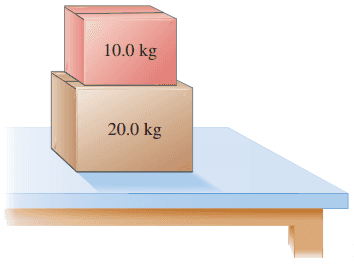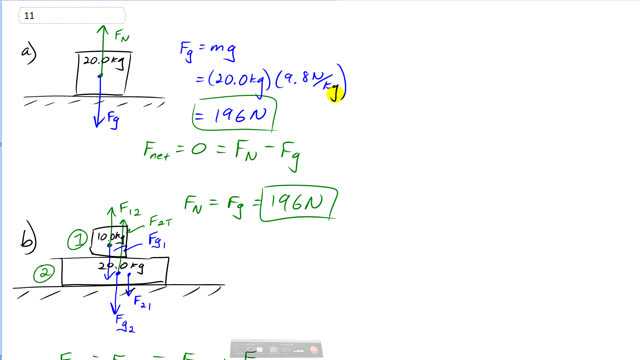
A 20.0-kg box rests on a table.
- What is the weight of the box and the normal force acting on it?
- A 10.0-kg box is placed on top of the 20.0-kg box, as shown in Fig. 4–43. Determine the normal force that the table exerts on the 20.0-kg box and the normal force that the 20.0-kg box exerts on the 10.0-kg box.


In order to watch this solution you need to have a subscription.
This is Giancoli Answers with Mr. Dychko. The weight on this 20 kilogram box is given by mass times the gravitational field strength, g. And g is 9.8 Newtons per kilogram times mass, 20 kilograms, gives 196 Newtons for the weight on this box. Now, the net force in the box is zero because it's not accelerating and the net force is also the normal force upwards minus the gravity downwards. And so, the normal force equals gravity, so, it is 196 Newtons. I guess technically I should have a negative sign in front of the gravity and a positive in front of the normal force but you get the idea from the picture that says the direction there, so, there's no need to be so explicit. Now, for Part B I'm gonna answer this question in a slightly more complicated way than you might normally do it because I want to cover a few things at the same time to do with Newton's third law and to give you an approach with this question that'll work in case you come across a question that's trying to be sneaky. For example you could have a question where the 10 kilogram box is on top of the 20 kilogram box and there's a cable on the 10 kilogram box so that pulling up a little bit so that the top box is not actually exerting its full weight on the bottom box. And in order to answer questions like that you need to have the technique I'm going to show here. So, the top box I'm gonna call number 1 and the bottom box is number 2 and this top box has a force on box 1 due to box 2. And that's also called the normal force on box 1. And here we have the force of gravity on box 1. And then in green here is force on box 2 due to the table. And that is the normal force exerted by the table. Normal force is just another name for a force exerted perpendicularly by an object. And this arrow here labels force of gravity in box 2 and this arrow labels the force of gravity, or sorry, it labels the force on box 2 due to box 1 which you might intuitively realize is the weight of box 1. But I'm writing it this way, like I say, to make it a more general case in case there's another question you come across one day where there's a cable pulling up a box on the top box or even a hand pushing down in the top box. OK. So, the normal force on box 2 is the first question will answer. And as I mentioned, it's the force on box 2 due to the table, and it's equal to the force of gravity on box 2 which is mg. Plus the force on box 2 due to box 1. So, the force on box 2 due to box 1 has the same magnitude as a force on box 1 due to 2, that's Newton's third law, these are third law counterparts here, these two forces. And the force on box 1 due to box 2 has to be equal to the force of gravity on box 1 because box 1 is not accelerating and this is the only other force on it. So, here's where if you had a hand or a cable pulling up or pushing down on the top box, the force on box 1 due to box 2 would be force of gravity plus some hand force maybe or minus some tension force upwards or something like that. So, here's where this approach becomes handy is when you can account for that. All right. So, now we can do a substitution for force on box 2 due to box 1, that's this one here. We're going to instead call it the force of gravity of box 1. And that's what I wrote here. So, normal force exerted on box 2 is the weight of box 2 plus the weight of box 1 as it turns out. And so, that's g times m2 plus m1, that's 9.8 Newtons per kilogram times 20 kilograms plus 10 kilograms, gives 294 Newtons, it is the force exerted on the box 2 due to the table which is also called the normal force on box 2. The normal force in box 1 is the force on box 1 due to box 2, as we showed, it's equal to the gravity on box 1, so, it's m1g and that's 98.0 Newtons.